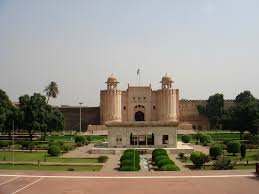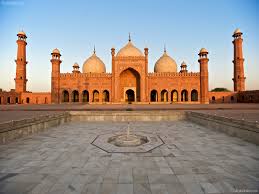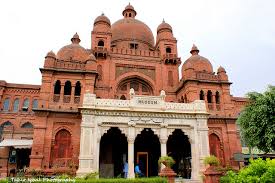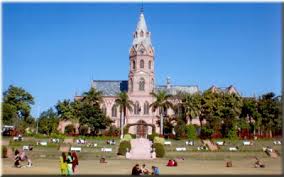







Lahore is the Capital city of Punjab Province of Pakistan. With the population of approximately 12 Million it is a lively city. The main attraction of the city is its beautiful Architecture and bustling Bazaars. The tradition of buildings is centuries old in Lahore but the Moghuls (1500AD to 1800AD) have contributed the most to it.
According to a legend Lahore was known in ancient times as Lavapuri ("City of Lava" in Sanskrit), was founded by Prince Lava or Loh, the son of Rama, the Hindu deity. To this day, Lahore Fort has a vacant temple dedicated to Lava (also pronounced Loh, hence Loh-awar or "The Fort of Loh").
Ptolemy, the 2nd-century Egyptian astronomer mentions in his Geographia a city called Labokla being somewhere between the Indus River and Palibothra, (Patna). It was described as extending along the rivers Bidastes or Vitasta (Jhelum), Sandabal or Chandra Bhaga (Chenab), and Adris or Iravati (Ravi).
The oldest authentic mention of Lahore appears in Hudud-i-Alam (The Regions of the World) written in 982. In this document, Lahore is mentioned as a shehr or town inhabited by non-muslims having "impressive temples, large markets and huge orchards." It refers to "two major markets around which dwellings exist," and it also mentions "the mud walls that enclose these two dwellings to make it one."
Although Lahore does not have an ancient history but Some historians & archeologists trace the history of the city as far back as 2000 BC. The famous chinese pilgrim Hieun-tsang has mentioned Lahore in his writings of 7th century.
Hindu Shahi Perior
Lahore is mentioned capital of the Punjab during the rein of Anandapala- the Hindu Shahi king who is referred to as the ruler of (hakim-e-lahur) after leaving the earlier capital of Waihind
Ghaznavid Empire to Delhi Sultanate
In 11th century the city was captured by Sultan Mahmud of Ghazni. The sultan took Lahore after a long siege and battle in which the city was burned and depopulated. In 1021, Sultan Mahmud appointed Malik Ayaz to the throne and made Lahore the capital of the Ghaznavid Empire of India. As the first Muslim governor of Lahore, Ayaz rebuilt and repopulated the city. He added many important features, such as city gates and a masonry fort, built in 1037–1040 on the ruins of the previous one, which had been demolished in the fighting (as recorded by Munshi Sujan Rae Bhandari, author of the Khulasatut Tawarikh in 1695–96). The present Lahore Fort stands on the same location. Under Ayaz's rule, the city became a cultural and academic center, renowned for poetry.[36] The tomb of Malik Ayaz can still be seen in the Rang Mahal commercial area of town.
Turk Dynasies
After the fall of the Ghaznavid Empire, Lahore was ruled by various Turk dynasties known as the Delhi Sultanate, including the Khiljis, Tughlaqs, Sayyid, Lodhis and Suris.[38] When Sultan Qutb-ud-din Aibak was crowned here in 1206, he became the first Muslim sultan in South Asia.[39] It was not until 1524 that Lahore became part of India's Mughal Empire.[40] During the reign of Qutbuddin Aibak, Lahore was known as the 'Ghazni of India'. Scholars and poets from as far away as Kashghar, Bukhara, Samarkand, Iraq, Khorasan and Herat, gathered in Lahore and made it a city of learning. Under Aibak, Lahore had more poets of Persia than any other Islamic city.
Lohanas
In the 13th Century, the Loharana king, Chahir Ray, was betrayed by his confidant Kualnger, who turned traitor for a large fortune in gold and gems. Due to this, the Lohana community split, and a new leader emerged who again unified the Lohanas. Veer Jashraj, who is revered as Veer Dada Jashraj, was born in the city of Lohar (today's Lahore in Pakistan), which was the capital of Lohargadh. His domain extended from Lahore to Multan. As the folklore goes, Mongol invader Changez Khan, attacked Multan and was killed by Dada Jashraj, Rana of Lohargadh.
This finds mention in Mongol folklore, which say, "King of Mongols was killed by Mirana, the tiger of Multan fort". His descendants who proudly carry the surname of 'Mirana' preserve the memory of this great warrior king. Dada Jashraj was also treacherously killed when only 28 - a life so short but full of heroic deeds.
After the death of Dada Jashraj, the decline of Lohana kingdom began and their reign at Lohargadh ended. King Dahir (Raja Dhahir) ruled for a while from Daibal (Banbhore 60 kilometers from today's Karachi).
After demise of Raja Dahir during the invasion of Arabs under Mohammed Bin Qasim, Daibal, Narayankot (Hyderabad) and other places of Sindh fell to Muslims. It was around this time that some Lohanas converted to Islam. Many migrated to far-off southern regions like Kutchchh, Saurashtra and Gujarat and gradually became a trader community like Agarwals and Baranwals.
Mughals 1524 to 1752 AD
In the 16th century after the arrival of the Moghul king Babur Lahore came to a new glory, Moghuals made Lahore their winter capital to escape the extreme winter of Delhi. The Mughals, famous as builders, gave Lahore great care and attention they built some of the finest architectural monuments in Lahore, many of which are becoming extant today.
Lahore as winter capital grew under emperor Babur; from 1584 to 1598, later the emperors Akbar the Great and Jahangir also added to its glory, the city served as the empire's capital. The peak of architectural reached during the reign of Shahjehan, who built many wonderful buildings in the city, many of these buildings and gardens today present a picture of Lahore old glory.
Lahore's reputation for beauty fascinated the English poet John Milton, who wrote "Agra and Lahore, the Seat of the Great Mughal" in 1670. During this time, the massive Lahore Fort was built. A few buildings within the fort were added by Akbar's son, Mughal emperor Jahangir, who is buried in the city. Jahangir's son, Shahjahan Burki, was born in Lahore. He, like his father, extended the Lahore Fort and built many other structures in the city, including the Shalimar Gardens. The last of the great Mughals, Aurangzeb, who ruled from 1658 to 1707, built the city's most famous monuments, the Badshahi Masjid and the Alamgiri Gate next to the Lahore Fort.
Post Mughal Era
During the 18th century, as Mughal power dwindled, Lahore was often invaded, and government authority was lacking. In 1739, Nader Shah, the Turkic emperor of Afsharid dynasty in Persia, invaded north western India, defeated the Mughal Emperor Mohammed Shah at the huge Battle of Karnal, and occupied most of Balochistan and the Indus plain including Lahore.[43] In 1747, the Durrani Empire was established in by Ahmad Shah Abdali in Afghanistan, during this period, Punjab saw frequent invasions by Ahmad Shah Abdali, The great Punjabi poet Baba Waris Shah said of the situation, "khada peeta wahy da, baqi Ahmad Shahy da" — "we have nothing with us except what we eat and wear, all other things are for Ahmad Shah". In 1758 the Maratha Empire's general Raghunathrao marched onwards, attacked and conquered Lahore and Attock and drove out Timur Shah Durrani, the son and viceroy of Ahmad Shah Abdali. Lahore, Multan, Kashmir and other subahs on the south and eastern side of Attock were under the Maratha rule for the most part. In Punjab and Kashmir, the Marathas were now major players.[44][45] In 1761, following the victory at the Third battle of Panipat between the Durrani and the Maratha Empire, Ahmad Shah Abdali captured remnants of the Maratha Empire in Punjab and Kashmir regions and had consolidated control over them.
Sikh reign
During the late 18th century, frequent invasions by Ahmad Shah Abdali and the Durrani Empire led to a lack of governance in the Punjab region. Invasions and chaos allowed bands of warring Sikhs to gain control in some areas. The Sikhs were gaining momentum at an enormous rate. In 1801, the twelve Sikh misls joined into one to form a new empire and sovereign Sikh state ruled by Maharaja Ranjit Singh.
When Zaman Shah invaded Punjab again in 1799 Ranjit Singh was able to make gains in the chaos. He defeated Zaman in a battle between Lahore and Amritsar. The citizens of Lahore, encouraged by Sada Kaur, offered him the city and he was able to take control of it in a series of battles with the Bhangi Misl and their allies. Lahore served as the capital city of the Sikh Empire.
While much of Lahore's Mughal era fabric lay in ruins by the end of eighteenth century, rebuilding efforts under the Sikhs were shaped by and indebted to Mughal practice. Ranjit Singh moved into the Mughal palace in Lahore's citadel. By 1812 he had mostly refurbished the city's defenses by adding a second circuit of outer walls that followed the outline of Akbar's original walls and were separated from them by a moat.
The maharaja also partially restored Shah Jahan's decaying gardens at Shalimar [disambiguation needed], and British maps of the area surrounding Lahore dating from the mid-nineteenth century show that walled private gardens - many of them bearing the names of prominent Sikh nobles - continued in the Mughal pattern under Sikh rule.
The Sikh court continued to endow religious architecture in the city, including a number of Sikh gurdwaras, Hindu temples, and mosques. In short, the decaying structures and architecture of Lahore was restored by the emperor. The Empire of the Sikhs was most exceptional in that it allowed men from religions other than their own to rise to commanding positions of authority. Besides the Sikh, Muslim and the Hindu feature as prominent administrators. The Christians formed a part of the militia of the Sikhs.
British Raj
Maharajah Ranjit Singh made Lahore his capital and was able to expand the kingdom to the Khyber Pass and also included Jammu and Kashmir, while keeping the British from expanding across the River Sutlej for more than 40 years. After his death in 1839 the internecine fighting between the Sikhs and several rapid forfeitures of territory by his sons, along with the intrigues of the Dogras and two Anglo-Sikh wars, eventually led to British control of the Lahore Darbar ten years later. For the British, Punjab was a frontier province, because Lahore had boundaries with Afghanistan and Persia.
Therefore, the Punjabis, unlike the Bengalis and the Sindhis, were not allowed to use their mother tongue as an official language. The British first introduced Urdu as an official language in Punjab,[48][49] including Lahore, allegedly due to a fear of Punjabi nationalism. Under British rule (1849–1947), colonial architecture in Lahore combined Mughal, Gothic and Victorian styles.
Under British rule, Sir Ganga Ram (sometimes referred to as the father of modern Lahore) designed and built the General Post Office, Lahore Museum, Aitchison College, Mayo School of Arts (now the NCA), Ganga Ram Hospital, Lady Mclagan Girls High School, the chemistry department of the Government College University, the Albert Victor wing of Mayo Hospital, Sir Ganga Ram High School (now Lahore College for Women) the Hailey College of Commerce, Ravi Road House for the Disabled, the Ganga Ram Trust Building on Shahrah-e-Quaid-e-Azam, and the Lady Maynard Industrial School.[50] He also constructed Model Town, a suburb that has recently developed into a cultural center for Lahore's growing socioeconomic elite.
The GPO and YMCA buildings in Lahore commemorated the golden jubilee of Queen Victoria, an event marked by the construction of clock towers and monuments all over British India. Other important British buildings included the High Court, the Government College University, the museums, the National College of Arts, Montgomery Hall, Tollinton Market, the University of the Punjab (Old Campus) and the Provincial Assembly.
Even today, Mall Road retains a variety of Gothic and Victorian style buildings built during the British Raj. At one end of The Mall stands the university, one of the most prestigious in Pakistan. The British also launched the city's first horse-racing club in 1924, starting a tradition that continues today at the Lahore Race Club.
Partition of British IndiaLahore played a special role in the independence movements of India. The 1929 Indian National Congress session was held at Lahore. In this Congress, the Declaration of the Independence of India was moved by Pandit Nehru and passed unanimously at midnight on 31 December 1929.[51] On this occasion, the contemporary tricolour of India (with a chakra at its centre) was hoisted for the first time as a national flag, and thousands of people saluted it.
Lahore's prison was used by the British to detain revolutionary freedom fighters. Noted freedom fighter Jatin Das died in Lahore's prison after fasting for 63 days in protest of British treatment of political prisoners. One of the greatest martyrs in the history of Indian independence, Shaheed Sardar Bhagat Singh, was hanged here.
The most important session of the All India Muslim League (later the Pakistan Muslim League), demanding the creation of Pakistan, was held in Lahore in 1940.[53] Muslims under the leadership of Quaid-e-Azam (Muhammad Ali Jinnah) demanded a separate homeland for Muslims of India in a document known as the Pakistan Resolution or the Lahore Resolution. It was during this session that Jinnah, the leader of the league, publicly proposed the Two-Nation Theory for the first time.
After the partition of British India, the Indian state of Punjab required a new capital city to replace Lahore, which had become part of Pakistan. After several plans to make additions to existing cities were found impractical for various reasons, it was decided to create a new city, Chandigarh.
Post-independenceUpon the creation of Pakistan, Lahore was made capital of the Punjab province in the new state of Pakistan. Almost immediately, large scale riots broke out among Muslims, Sikhs and Hindus, causing many deaths as well as damage to historic monuments—including the Lahore Fort, Badshahi mosque and other colonial buildings.[56] With United Nations assistance, the government was able to rebuild Lahore, and most scars of the communal violence of independence were erased. Less than 20 years later, however, Lahore once again became a battleground in the War of 1965. The battlefield and trenches can still be observed today close to the Wagah border area.
After independence, Lahore lost much of its glory, but in the 1990s, Lahore once again gained its significance as an economic and cultural powerhouse through government reforms. The second Islamic Summit Conference was held in the city. In 1996 the International Cricket Council Cricket World Cup final match was held at the Gaddafi Stadium in Lahore.
The Walled City of Lahore known locally as the "Un-droone Shehr" is the oldest and most historic part of Lahore. The Punjab government embarked on a major project in 2009 to restore the Royal Trail (Shahi Guzar Gah) from Akbari Gate to the Lahore Fort with the help of the World Bank under the Sustainable Development of the Walled City of Lahore (SDWCL) project. The project aims at the Walled City development, at exploring and highlighting economic potential of the Walled City as a cultural heritage, exploring and highlighting the benefits of the SWDCL project for the residents, and at soliciting suggestions regarding maintenance of development and conservation of the Walled City. This city is famous of historic places i.e. Badshahi masjid, Minaar Pakistan.



